Unveiling the Terahertz Nano-Fingerprint Spectrum of Single Artificial Metallic Resonator
Abstract
1. Introduction
2. Materials and Methods
2.1. Experimental Setup
2.2. Material Preparation
2.3. Methods of Detection
2.4. Data Processing
3. Results
4. Discussion
5. Conclusions
Author Contributions
Funding
Institutional Review Board Statement
Informed Consent Statement
Data Availability Statement
Conflicts of Interest
Appendix A
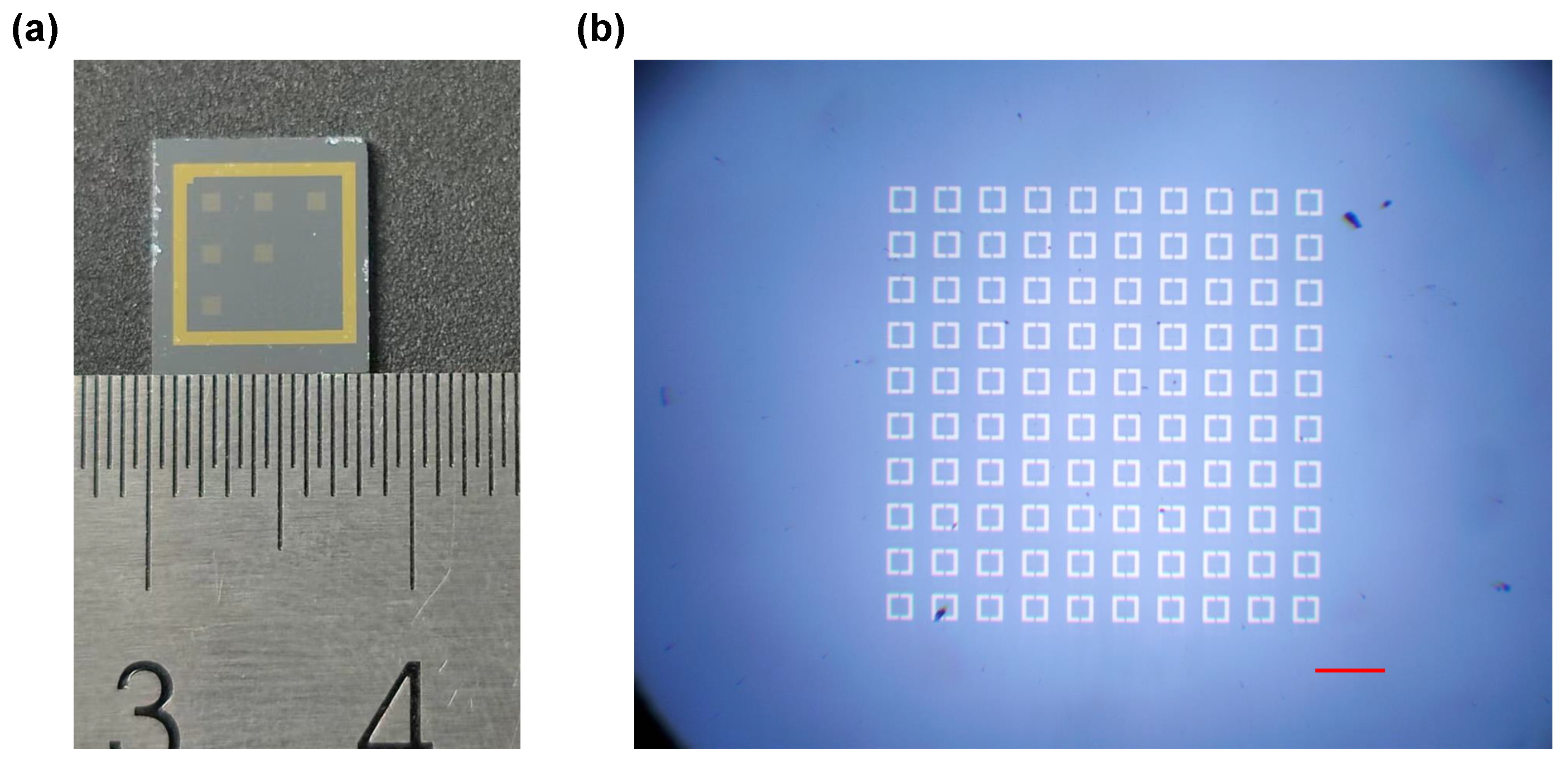

References
- Liu, Y.; Bai, Z.; Xu, Y.; Wu, X.; Sun, Y.; Li, H.; Sun, T.; Kong, R.; Pandey, C.; Kraft, M.; et al. Generation of tailored terahertz waves from monolithic integrated metamaterials onto spintronic terahertz emitters. Nanotechnology 2020, 32, 105201. [Google Scholar] [CrossRef] [PubMed]
- Yu, X.; Suzuki, Y.; Van Ta, M.; Suzuki, S.; Asada, M. Highly Efficient Resonant Tunneling Diode Terahertz Oscillator With a Split Ring Resonator. IEEE Electron Device Lett. 2021, 42, 982–985. [Google Scholar] [CrossRef]
- Pu, M.; Luo, X. Advancing nonlinear nanophotonics: Harnessing membrane metasurfaces for third-harmonic generation and imaging. Opto-Electron. Adv. 2023, 6, 230153. [Google Scholar] [CrossRef]
- Degl’Innocenti, R.; Lin, H.; Navarro-Cia, M. Recent progress in terahertz metamaterial modulators. Nanophotonics 2022, 11, 1485–1514. [Google Scholar] [CrossRef]
- Li, J.; Wang, G.; Yue, Z.; Liu, J.; Li, J.; Zheng, C.; Zhang, Y.; Zhang, Y.; Yao, J. Dynamic phase assembled terahertz metalens for reversible conversion between linear polarization and arbitrary circular polarization. Opto-Electron. Adv. 2022, 5, 210062. [Google Scholar] [CrossRef]
- Zhao, H.; Wang, X.; Liu, S.; Zhang, Y. Highly efficient vectorial field manipulation using a transmitted tri-layer metasurface in the terahertz band. Opto-Electron. Adv. 2023, 6, 220012. [Google Scholar] [CrossRef]
- Gao, H.; Fan, X.; Liu, S.; Wang, Y.; Liu, Y.; Wang, X.; Xu, K.; Deng, L.; Zeng, C.; Li, T.; et al. Multi-foci metalens for spectra and polarization ellipticity recognition and reconstruction. Opto-Electron Sci. 2023, 2, 220026. [Google Scholar] [CrossRef]
- Li, Y.; Huang, X.; Liu, S.; Liang, H.; Ling, Y.; Su, Y. Metasurfaces for near-eye display applications. Opto-Electron Sci. 2023, 2, 230025. [Google Scholar] [CrossRef]
- Singh, R.; Cao, W.; Al-Naib, I.; Cong, L.; Withayachumnankul, W.; Zhang, W. Ultrasensitive terahertz sensing with high-Q Fano resonances in metasurfaces. Appl. Phys. Lett. 2014, 105, 171101. [Google Scholar] [CrossRef]
- Srivastava, Y.K.; Ako, R.T.; Gupta, M.; Bhaskaran, M.; Sriram, S.; Singh, R. Terahertz sensing of 7 nm dielectric film with bound states in the continuum metasurfaces. Appl. Phys. Lett. 2019, 115, 151105. [Google Scholar] [CrossRef]
- Wang, R.; Xu, L.; Huang, L.; Zhang, X.; Ruan, H.; Yang, X.; Lou, J.; Chang, C.; Du, X. Ultrasensitive Terahertz Biodetection Enabled by Quasi-BIC-Based Metasensors. Small 2023, 19, e2301165. [Google Scholar] [CrossRef] [PubMed]
- Cui, F.; Huang, X.; Zhou, Q.; Tong, Y.; Liu, F.; Tang, Y.; Meng, X.; Li, C.; Fang, B.; Jing, X. Magnetic toroidal dipole resonance terahertz wave biosensor based on all-silicon metasurface. Opt. Lasers Eng. 2024, 177, 108128. [Google Scholar] [CrossRef]
- Xiong, H.; Li, X.-M. Parametric Investigation and Analysis of an Electric-LC Resonator by Using LC Circuit Model. Appl. Comput. Electromagn. Soc. 2020, 35, 1113–1118. [Google Scholar] [CrossRef]
- Chen, H.S.; Ran, L.X.; Huangfu, J.T.; Grzegorczyk, T.M.; Kong, J.A. Equivalent circuit model for left-handed metamaterials. J. Appl. Phys. 2006, 100, 024915. [Google Scholar] [CrossRef]
- Smith, D.R.; Vier, D.C.; Koschny, T.; Soukoulis, C.M. Electromagnetic parameter retrieval from inhomogeneous metamaterials. Phys. Rev. E 2005, 71, 036617. [Google Scholar] [CrossRef]
- Zhou, J.F.; Zhang, L.; Tuttle, G.; Koschny, T.; Soukoulis, C.M. Negative index materials using simple short wire pairs. Phys. Rev. B 2006, 73, 041101. [Google Scholar] [CrossRef]
- Datta, S.; Prasertsuk, K.; Khammata, N.; Rattanawan, P.; Chia, J.Y.; Jintamethasawat, R.; Chulapakorn, T.; Limpanuparb, T. Terahertz Spectroscopic Analysis of Lactose in Infant Formula: Implications for Detection and Quantification. Molecules 2022, 27, 5040. [Google Scholar] [CrossRef] [PubMed]
- Lee, J.E.; Lee, H.; Kim, J.; Jung, T.S.; Kim, J.H.; Kim, J.; Baek, N.Y.; Song, Y.N.; Lee, H.H.; Kim, J.H. Terahertz Spectroscopic Analysis of the Vermilion Pigment in Free-Standing and Polyethylene-Mixed Forms. ACS Omega 2021, 6, 13802–13806. [Google Scholar] [CrossRef]
- Cocker, T.L.; Jelic, V.; Hillenbrand, R.; Hegmann, F.A. Nanoscale terahertz scanning probe microscopy. Nat. Photonics 2021, 15, 558–569. [Google Scholar] [CrossRef]
- Chen, X.; Hu, D.; Mescall, R.; You, G.; Basov, D.N.; Dai, Q.; Liu, M. Modern Scattering-Type Scanning Near-Field Optical Microscopy for Advanced Material Research. Adv. Mater. 2019, 31, e1804774. [Google Scholar] [CrossRef]
- Chen, S.; Leng, P.L.; Konecna, A.; Modin, E.; Gutierrez-Amigo, M.; Vicentini, E.; Martin-Garcia, B.; Barra-Burillo, M.; Niehues, I.; Escudero, C.M.; et al. Real-space observation of ultraconfined in-plane anisotropic acoustic terahertz plasmon polaritons. Nat. Mater. 2023, 22, 860–866. [Google Scholar] [CrossRef] [PubMed]
- Yuan, Z.; Chen, R.K.; Li, P.N.; Nikitin, A.Y.; Hillenbrand, R.; Zhang, X.L. Extremely Confined Acoustic Phonon Polaritons in Monolayer-hBN/Metal Heterostructures for Strong Light-Matter Interactions. ACS Photonics 2020, 7, 2610–2617. [Google Scholar] [CrossRef]
- van Hoof, N.J.J.; Abujetas, D.R.; Ter Huurne, S.E.T.; Verdelli, F.; Timmermans, G.C.A.; Sanchez-Gil, J.A.; Rivas, J.G. Unveiling the Symmetry Protection of Bound States in the Continuum with Terahertz Near-Field Imaging. ACS Photonics 2021, 8, 3010–3016. [Google Scholar] [CrossRef]
- ter Huurne, S.; Abujetas, D.R.; van Hoof, N.; Sanchez-Gil, J.A.; Gómez Rivas, J. Direct Observation of Lateral Field Confinement in Symmetry-Protected THz Bound States in the Continuum. Adv. Opt. Mater. 2023, 11, 2202403. [Google Scholar] [CrossRef]
- Hale, L.L.; Keller, J.; Siday, T.; Hermans, R.I.; Haase, J.; Reno, J.L.; Brener, I.; Scalari, G.; Faist, J.; Mitrofanov, O. Noninvasive Near-Field Spectroscopy of Single Subwavelength Complementary Resonators. Laser Photonics Rev. 2020, 14, 1900254. [Google Scholar] [CrossRef]
- Lu, Y.; Hale, L.L.; Zaman, A.M.; Addamane, S.J.; Brener, I.; Mitrofanov, O.; Degl’Innocenti, R. Near-Field Spectroscopy of Individual Asymmetric Split-Ring Terahertz Resonators. ACS Photonics 2023, 10, 2832–2838. [Google Scholar] [CrossRef]
- Maissen, C.; Chen, S.; Nikulina, E.; Govyadinov, A.; Hillenbrand, R. Probes for Ultrasensitive THz Nanoscopy. ACS Photonics 2019, 6, 1279–1288. [Google Scholar] [CrossRef]
- Zeng, Y.; Lu, D.; Xu, X.; Zhang, X.; Wan, H.; Wang, J.; Jiang, X.; Yang, X.; Xu, M.; Wen, Q.; et al. Laser-Printed Terahertz Plasmonic Phase-Change Metasurfaces. Adv. Opt. Mater. 2023, 11, 2202651. [Google Scholar] [CrossRef]
- Degl’Innocenti, R.; Wallis, R.; Wei, B.; Xiao, L.; Kindness, S.J.; Mitrofanov, O.; Braeuninger-Weimer, P.; Hofmann, S.; Beere, H.E.; Ritchie, D.A. Terahertz Nanoscopy of Plasmonic Resonances with a Quantum Cascade Laser. ACS Photonics 2017, 4, 2150–2157. [Google Scholar] [CrossRef]
- Thomas, L.; Hannotte, T.; Santos, C.N.; Walter, B.; Lavancier, M.; Eliet, S.; Faucher, M.; Lampin, J.F.; Peretti, R. Imaging of THz Photonic Modes by Scattering Scanning Near-Field Optical Microscopy. ACS Appl. Mater. Interfaces 2022, 14, 32608–32617. [Google Scholar] [CrossRef]
- Sulollari, N.; Keeley, J.; Park, S.; Rubino, P.; Burnett, A.D.; Li, L.; Rosamond, M.C.; Linfield, E.H.; Davies, A.G.; Cunningham, J.E.; et al. Coherent terahertz microscopy of modal field distributions in micro-resonators. APL Photonics 2021, 6, 066104. [Google Scholar] [CrossRef]
- Cvitkovic, A.; Ocelic, N.; Hillenbr, R. Analytical model for quantitative prediction of material contrasts in scattering-type near-field optical microscopy. Opt. Express 2007, 15, 8550–8565. [Google Scholar] [CrossRef] [PubMed]
- Mastel, S.; Lundeberg, M.B.; Alonso-González, P.; Gao, Y.; Watanabe, K.; Taniguchi, T.; Hone, J.; Koppens, F.H.; Nikitin, A.Y.; Hillenbr, R. Terahertz Nanofocusing with Cantilevered Terahertz-Resonant Antenna Tips. Nano Lett. 2017, 17, 6526–6533. [Google Scholar] [CrossRef] [PubMed]
- Siday, T.; Natrella, M.; Wu, J.; Liu, H.; Mitrofanov, O. Resonant terahertz probes for near-field scattering microscopy. Opt. Express 2017, 25, 27874–27885. [Google Scholar] [CrossRef]
- Moon, K.; Do, Y.; Park, H.; Kim, J.; Kang, H.; Lee, G.; Lim, J.H.; Kim, J.W.; Han, H. Computed terahertz near-field mapping of molecular resonances of lactose stereo-isomer impurities with sub-attomole sensitivity. Sci. Rep. 2019, 9, 16915. [Google Scholar] [CrossRef]
- Mester, L.; Govyadinov, A.A.; Chen, S.; Goikoetxea, M.; Hillenbr, R. Subsurface chemical nanoidentification by nano-FTIR spectroscopy. Nat. Commun. 2020, 11, 3359. [Google Scholar] [CrossRef]
- Hu, M.; Zhang, X.; Zhang, X.; Zhang, Z.; Zhang, T.; Xu, X.; Tang, F.; Yang, J.; Wang, J.; Jiang, H.; et al. Time-domain-filtered terahertz nanoscopy of intrinsic light-matter interactions. Res. Sq. 2023. [Google Scholar] [CrossRef]
- McLeod, A.S.; Kelly, P.; Goldflam, M.D.; Gainsforth, Z.; Westphal, A.J.; Dominguez, G.; Thiemens, M.H.; Fogler, M.M.; Basov, D.N. Model for quantitative tip-enhanced spectroscopy and the extraction of nanoscale-resolved optical constants. Phys. Rev. B 2014, 90, 085136. [Google Scholar] [CrossRef]
- Caselli, N.; Intonti, F.; La China, F.; Biccari, F.; Riboli, F.; Gerardino, A.; Li, L.; Linfield, E.H.; Pagliano, F.; Fiore, A.; et al. Generalized Fano lineshapes reveal exceptional points in photonic molecules. Nat. Commun. 2018, 9, 396. [Google Scholar] [CrossRef]
- Cong, L.; Singh, R. Symmetry-Protected Dual Bound States in the Continuum in Metamaterials. Adv. Opt. Mater. 2019, 7, 1900383. [Google Scholar] [CrossRef]
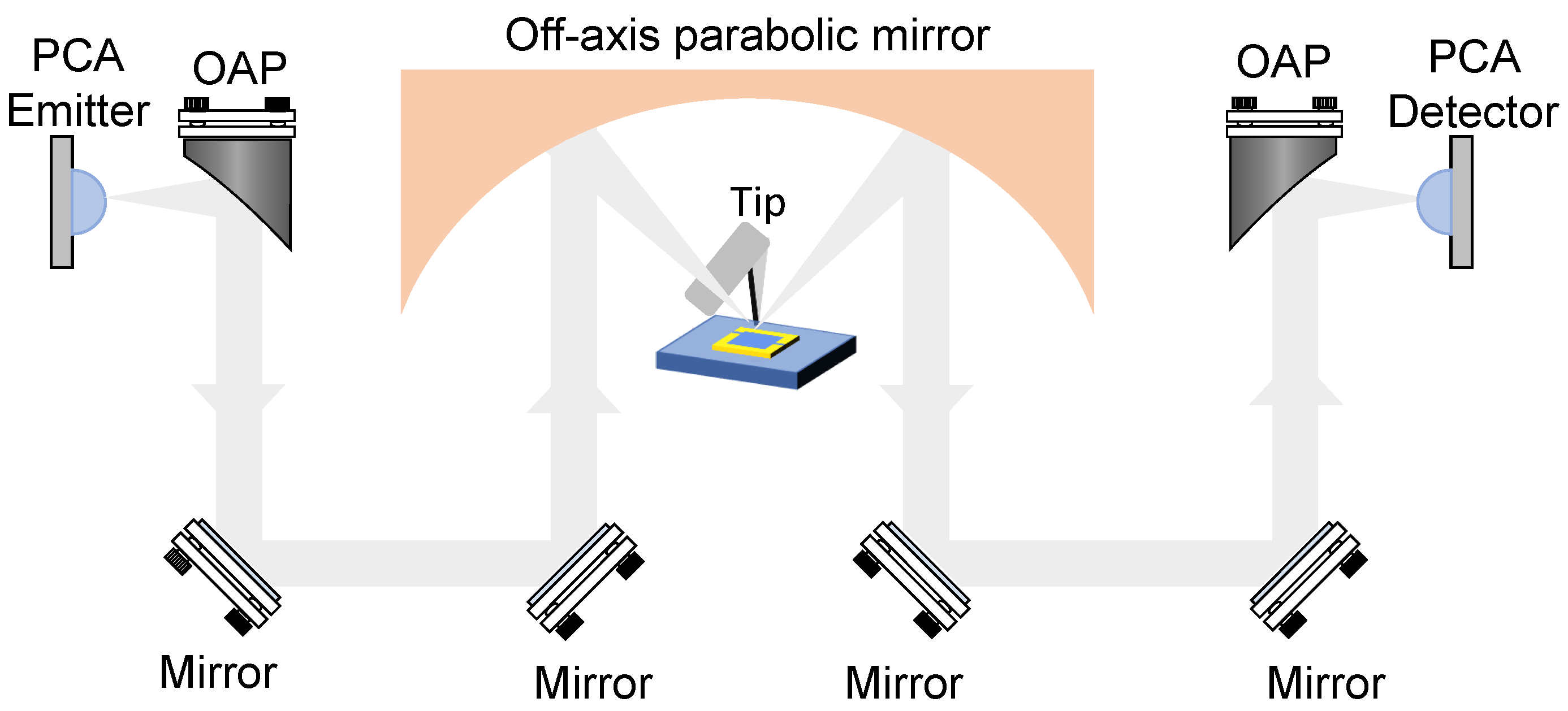
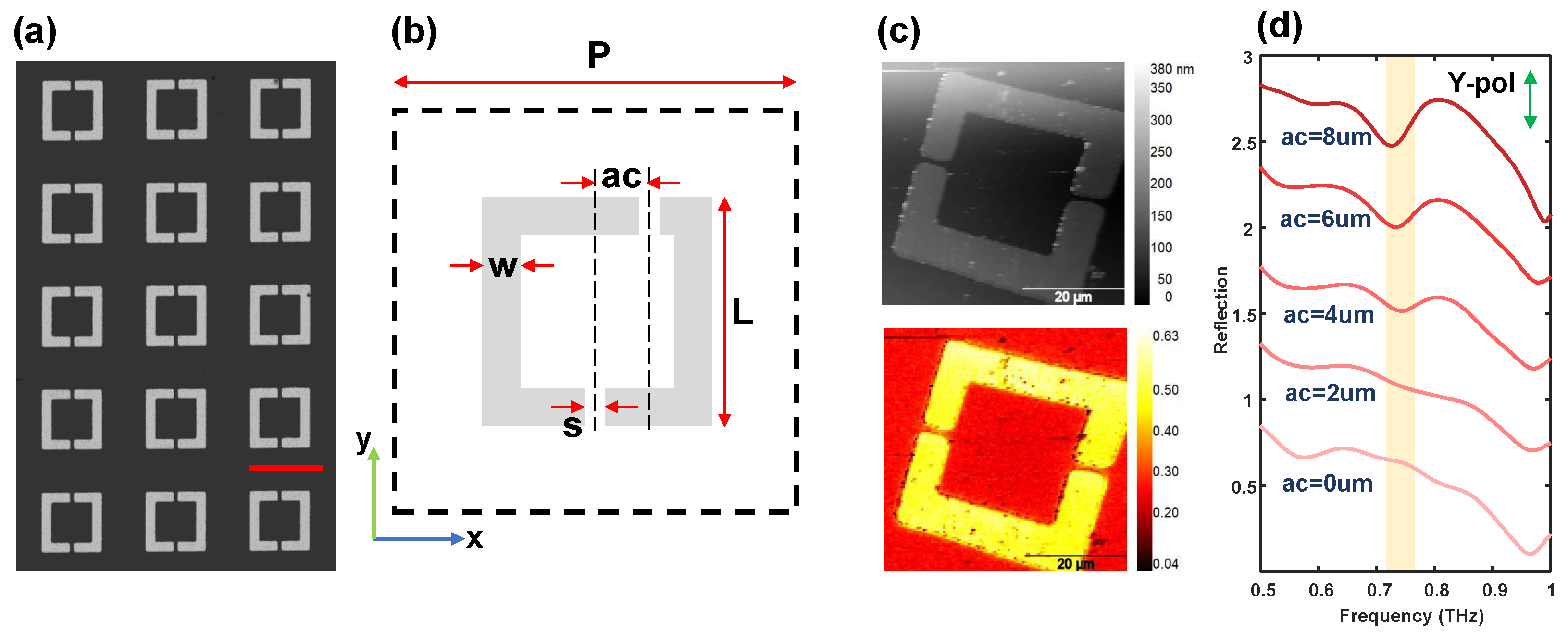
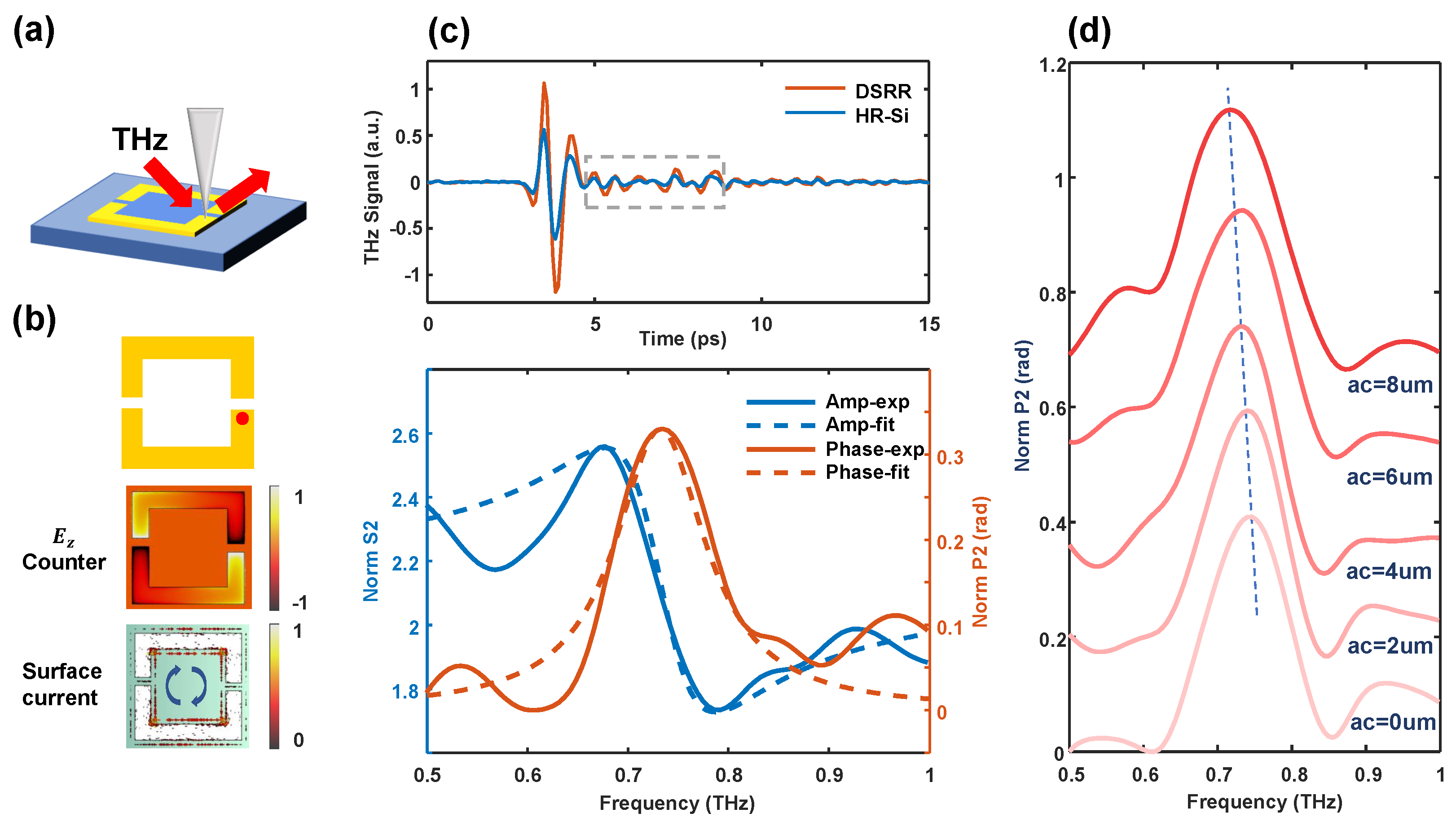
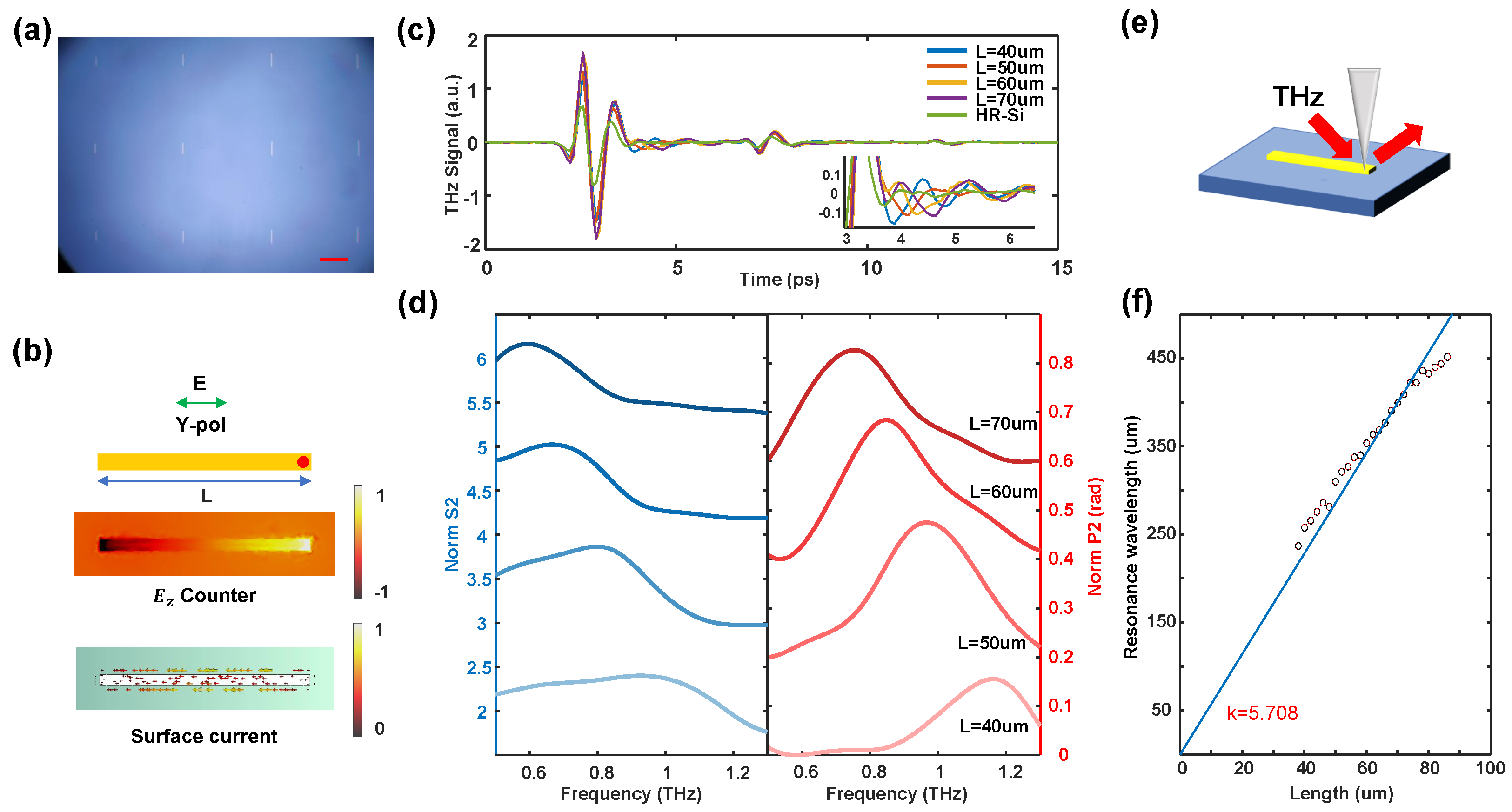
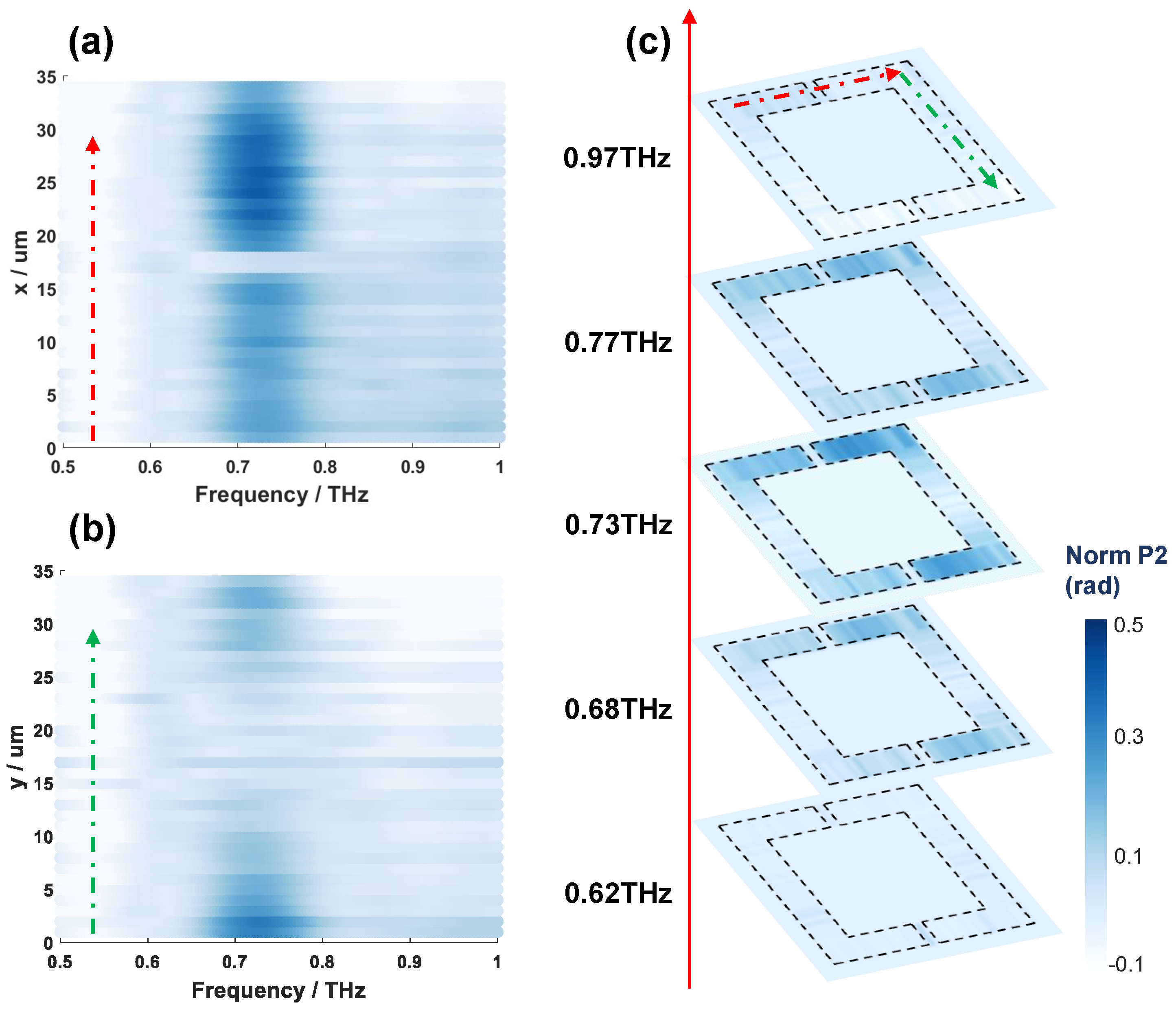
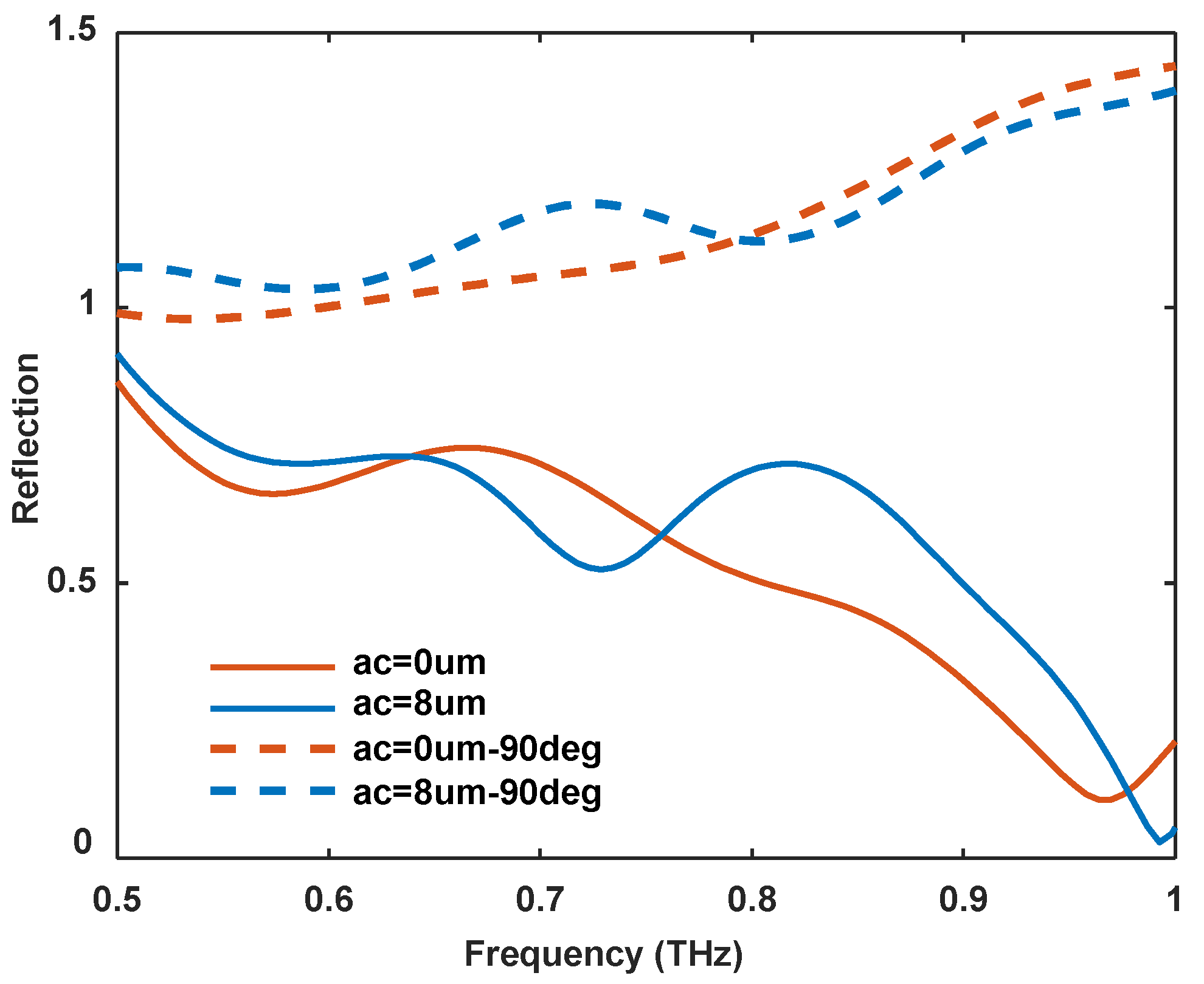
Disclaimer/Publisher’s Note: The statements, opinions and data contained in all publications are solely those of the individual author(s) and contributor(s) and not of MDPI and/or the editor(s). MDPI and/or the editor(s) disclaim responsibility for any injury to people or property resulting from any ideas, methods, instructions or products referred to in the content. |
© 2024 by the authors. Licensee MDPI, Basel, Switzerland. This article is an open access article distributed under the terms and conditions of the Creative Commons Attribution (CC BY) license (https://creativecommons.org/licenses/by/4.0/).
Share and Cite
Xu, X.; Tang, F.; Zhang, X.; Liu, S. Unveiling the Terahertz Nano-Fingerprint Spectrum of Single Artificial Metallic Resonator. Sensors 2024, 24, 5866. https://doi.org/10.3390/s24185866
Xu X, Tang F, Zhang X, Liu S. Unveiling the Terahertz Nano-Fingerprint Spectrum of Single Artificial Metallic Resonator. Sensors. 2024; 24(18):5866. https://doi.org/10.3390/s24185866
Chicago/Turabian StyleXu, Xingxing, Fu Tang, Xiaoqiuyan Zhang, and Shenggang Liu. 2024. "Unveiling the Terahertz Nano-Fingerprint Spectrum of Single Artificial Metallic Resonator" Sensors 24, no. 18: 5866. https://doi.org/10.3390/s24185866
APA StyleXu, X., Tang, F., Zhang, X., & Liu, S. (2024). Unveiling the Terahertz Nano-Fingerprint Spectrum of Single Artificial Metallic Resonator. Sensors, 24(18), 5866. https://doi.org/10.3390/s24185866



